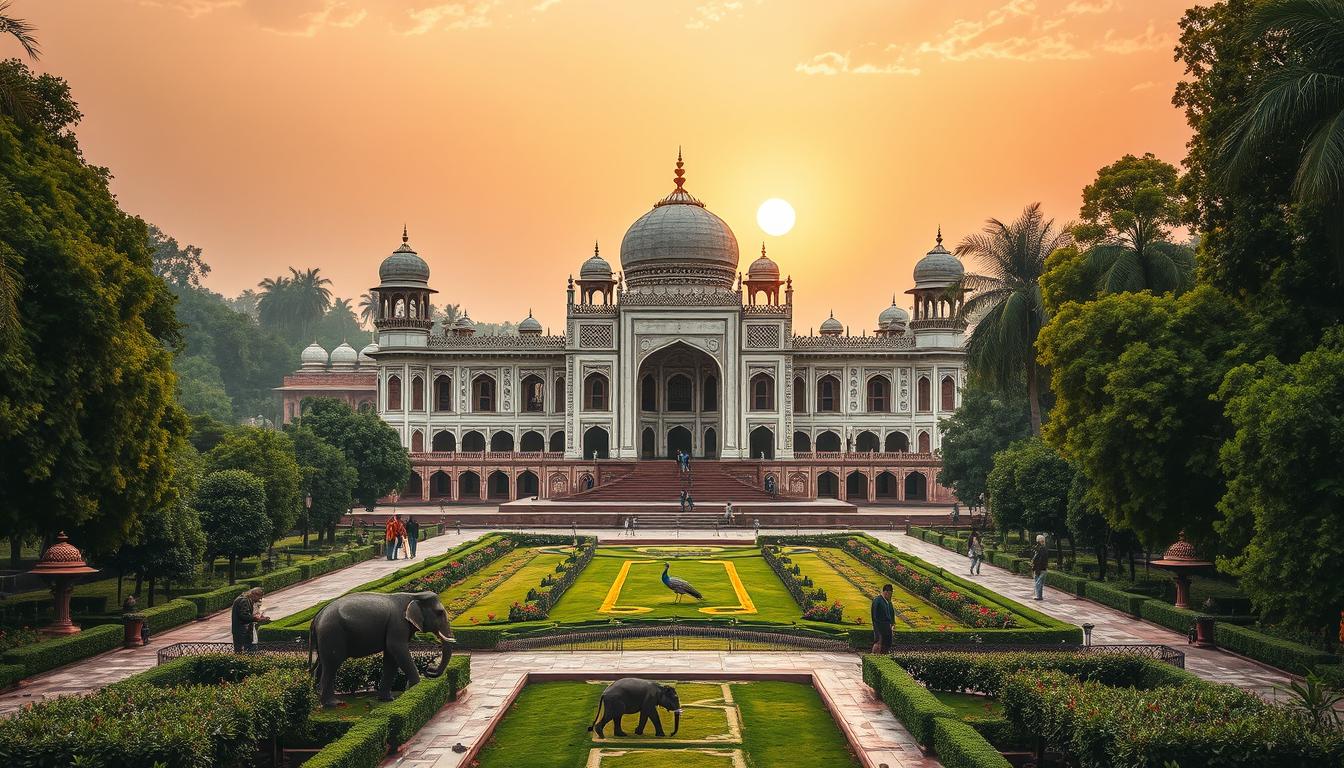Decline of the Mughal Empire
The Mughal Empire once ruled over a vast area. Its decline marked a big change in India’s history. This change deeply affected the power of the empire1. The decline happened from the early 18th century to the mid-19th century. Understanding this period is key to knowing India’s past1.
The Mughal dynasty ruled northern India from the 16th to the 18th century. They controlled a lot of India for over two hundred years2.
The story of the Mughal Empire’s decline is interesting. We will look at why it fell, including economic troubles, bad management, and religious fights. These issues hurt the empire and its power1. The Mughals tried to unite Hindus and Muslims but failed. This failure led to power being split and the empire losing control2.
Key Takeaways
- The decline of the Mughal Empire was a big event in India’s history, lasting about 145 years1.
- The Mughal dynasty ruled much of India for over two centuries2.
- The decline of the Mughal Empire greatly affected the empire’s power and the Indian economy1.
- The Mughals tried to unite Hindus and Muslims but failed2.
- The decline of the Mughal Empire caused power to be split and control to be lost1.
- The Mughal Empire’s legacy continues to influence India’s culture and politics today2.
Causes of the Mughal Decline
The Mughal Empire’s downfall was caused by many factors. These factors weakened its base in the Indian subcontinent.
Economic Factors
An ongoing economic crisis hit the empire hard. Irfan Habib says the rich taking too much from the poor left the empire without support3. Jeffrey G. Williamson also notes that the Indian economy lost its industrial edge in the 18th century, partly because of the empire’s decline3.
Later rulers’ heavy taxes made things worse. This made it hard to keep the empire together4.
Administrative Inefficiencies
Weak administration also played a part. After Aurangzeb, disputes among heirs weakened control3. The empire’s later rulers struggled to manage their vast lands4.
Religious Conflicts
Religious issues also split the empire. Aurangzeb’s strict rules upset many people, causing unrest3. His Deccan policy hurt the army and the empire’s reputation, leading to its fall3.
| Factor | Description | Source |
|---|---|---|
| Economic Crisis | Exploitation of peasantry and deindustrialization | 3 |
| Political Fragmentation | Weak successors and internal disputes | 34, |
| Religious Conflicts | Aurangzeb’s policies causing unrest | 3 |
Key Events Leading to the Fall
The Mughal Empire’s decline was sped up by key events. These events weakened the empire’s base.
The Rebellion of Maratha
The Maratha rebellion was a big challenge to Mughal rule. It disrupted control and grew regional power5. Leaders like Shivaji were key in fighting against the empire.
Nadir Shah’s Invasion
In 1739, Nadir Shah’s invasion hit the Mughal Empire hard. It took away its resources and lowered its status5. This showed how weak the empire was to outside threats.
The Rise of Regional Powers
As the empire weakened, provinces started to break free. This led to the rise of local powers56. These local leaders set up their own kingdoms, breaking Mughal control.
| Event | Year | Impact | Reference |
|---|---|---|---|
| Aurangzeb’s Death | 1707 | Marked the beginning of the Mughal decline | 5 |
| Nadir Shah’s Invasion | 1739 | Significant depletion of resources and prestige | 5 |
| Battle of Plassey | 1757 | British East India Company gains control of Bengal | 6 |
| British Colony Establishment | 1857-1858 | Official end of the Mughal Empire | 6 |
Legacy of the Mughal Decline
The fall of the Mughal Empire deeply changed the Indian subcontinent. It shaped its culture and politics for many years.
Cultural Impacts
As the Mughals lost power, art and architecture kept growing. Traditional Mughal art mixed with new European styles. This mix is seen in today’s Indian buildings and crafts.
Social structures also changed. They showed how power and influence moved across the region.
Political Consequences
The Mughal Empire’s weakness let the British East India Company step in. They started with trade but soon grew stronger. The key Battle of Plassey in 1757 was a turning point.
There, British forces beat the Nawab of Bengal and his French allies7. This victory started British rule over much of India. It changed India’s history forever.
Historical Interpretations
Historians argue about why the Mughal Empire fell. Some say it was due to internal problems and outside pressures. Others point to cultural and economic factors.
These views help us grasp India’s complex past. They show how it affects us today.
FAQ
What were the primary economic factors that led to the decline of the Mughal Empire?
How did administrative inefficiencies contribute to the Mughal decline?
In what ways did Aurangzeb’s policies impact the Mughal Empire’s stability?
What role did the British East India Company play in the fall of the Mughal Empire?
How did external invasions, such as Nadir Shah’s invasion, affect the Mughal Empire?
What was the significance of the Maratha rebellion in the context of the Mughal decline?
How did the decline of the Mughal Empire influence modern India?
What are some historical interpretations of the Mughal Empire’s decline?
Source Links
- Decline of the Mughal Empire – https://en.wikipedia.org/wiki/Decline_of_the_Mughal_Empire
- Mughal dynasty | Map, Rulers, Decline, & Facts | Britannica – https://www.britannica.com/topic/Mughal-dynasty
- PDF – https://www.bhu.ac.in/Content/Syllabus/Syllabus_300620200413052929.pdf
- 7 reasons that led to the decline of Mughal Empire – https://timesofindia.indiatimes.com/etimes/trending/7-reasons-that-led-to-the-decline-of-mughal-empire/photostory/107915858.cms
- Fall of Mughal Empire – https://unacademy.com/content/upsc/study-material/modern-indian-history/fall-of-mughal-empire/
- Indian rebellion and the decline of the Mughal Empire – Mughal India – KS3 History – BBC Bitesize – https://www.bbc.co.uk/bitesize/articles/zmkb9ty
- Mughal Dynasty: Influence, Legacy | Vaia – https://www.vaia.com/en-us/explanations/history/the-mughal-empire/mughal-dynasty/
latest video
news via inbox
Nulla turp dis cursus. Integer liberos euismod pretium faucibua








